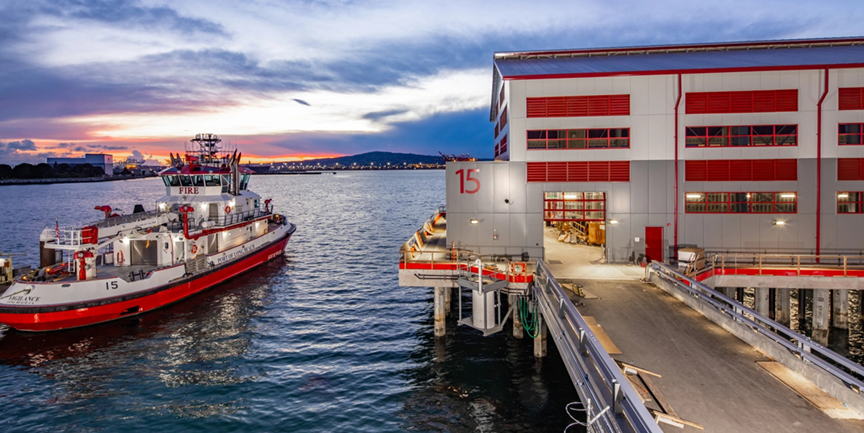More than a decade after an independent study found that fire safety facilities and equipment at the Port of Long Beach were in urgent need of modernization, a gleaming new fire station has opened at the port.
Fire Station No. 15, a 20,000-square foot facility with an 11,200-square foot covered boat bay, is now operational.
“This moment has been a long time coming,” Port of Long Beach Executive Director Mario Cordero said. “It’s an important milestone for the safety of the Long Beach community and this critical national economic engine.”
Station 15, located on Pier F between Middle Harbor and the port’s Joint Command and Control Center, overlooks the outer harbor. Pier F is also home to a Chemoil marine terminal that handles flammable liquids, so having a state-of-the-art fire station nearby is a necessity for the port.
In 2010, a technical assessment found that two of the port’s fireboats and two fire stations needed to be replaced. The fireboats, which were 24 years old at the time of the study, each lacked the hull capacity to pack enough foam and the stream reach to respond to a fire on container ships whose capacity had grown from about 4,000 twenty-foot equivalent units (TEUs) to about 12,000 TEUs.
“The study, jointly commissioned by the port and the (Long Beach) Fire Department, confirmed we now had higher requirements for response times and capabilities to protect lives and property within the port complex,” Thomas Baldwin, the director of program management for the port’s Engineering Services Bureau, explained.
The joint study also found that upgrading the existing boats wasn’t an option, and that the mobile structures that housed crews at Fire Stations 15 and 20 were also at the end of their life cycles and needed to be replaced.
The issue has become even more acute over the past decade, as container throughput has increased. Currently, the average container ship calling at the port is an 8,000-TEU vessel; however, ships that carry up to 24,000 TEUs have also called. In 2020 the POLB handled a record 8.1 million TEUs, according to data, despite the COVID-19 pandemic.
Specially Equipped
Due to the need for both landside and waterside response capabilities, Fireboat Station No. 15 is more extensively equipped than a neighborhood fire station. Key features of the single-story facility include advanced communications technology, a workshop where crews can maintain and repair gear, a conference room, a data room, office space, living quarters for a six-member team, and a garage large enough to house a fire engine and a second emergency vehicle.
The new boat bay, which reaches more than 52 feet above the water’s surface, will shelter one of the port’s state-of-the-art fireboats, Vigilance, when the vessel’s not in use. The covered dock’s equipment includes an overhead crane to perform machinery maintenance on the fireboat, as well as necessary firefighting materials and equipment; a deionizing system to remove sea salt deposits that can slow the vessel’s speed and corrode the hull; a dive locker; and its own maintenance and repair room.
In addition to lengthening the vessel’s service life, protecting the vessel from the elements also saves time and money on ongoing maintenance, giving crews more time for readiness-increasing training and drills, according to port officials.
The new fire station, which was built to last 50 years in a harsh marine environment, is just one component of a multi-part program to modernize the port’s fire safety services. With Station 15 now open, construction is expected begin this year on a new, permanent Fireboat Station No. 20, which is designed as a two-story structure with all the same features as Station 15, and would be located in the inner harbor.
Both fireboat station designs incorporate sustainability features, including the use of water-saving technology; green power generation; energy-efficient appliances; natural ventilation; and other environmentally sustainable features.
The total estimated cost for the two stations is nearly $109 million, according the port, a cost that’s been deemed very necessary.
“As a critical gateway to commerce and an asset that powers the local and national economy,” Cordero said, “we want our customers and the community to know that the Port of Long Beach is investing in all kinds of infrastructure to ensure we have the best facilities and services to support business continuity.”

